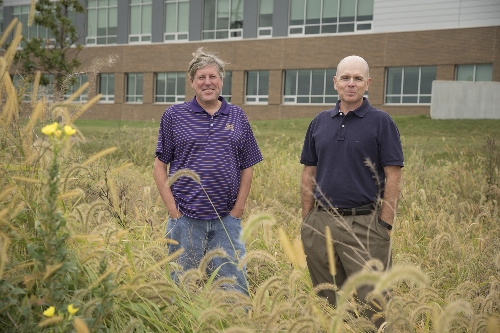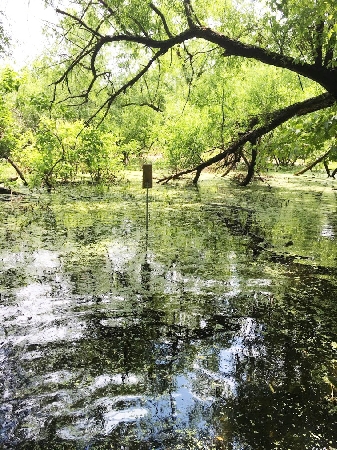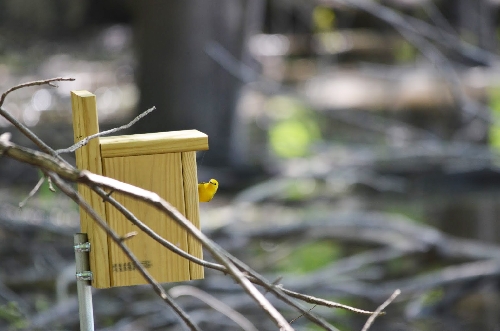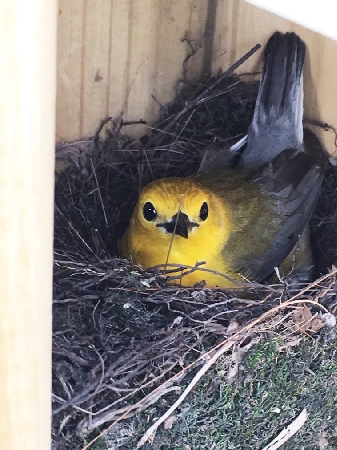University News
Cross-Departmental Project Benefits Natural Resources in QCs
October 6, 2016
MOLINE, IL – Collaboration between two Western Illinois University professors in different academic departments is resulting in educational and research opportunities for the students of each educator and enhancements in two natural areas in the Quad Cities region.
WIU Biology Professor Brian Peer and Recreation, Park and Tourism Administration (RPTA) Associate Professor Rob Porter have partnered on two projects to benefit natural resources in the Quad Cities. The first is to create habitat for wildlife research and outdoor recreation at Nahant Marsh's Carp Lake, and the second creates a native pocket prairie on WIU's Quad Cities campus.
The Prothonotary Project, at Nahant Marsh's Carp Lake on the west side of Davenport, IA, began when Porter took classes to the nature area.
"I talked to the director and said we are either going to have to dive into working in this area or look for another space, and they offered us 40 acres of wetland to manage," said Porter. "My classes in open space management and outdoor recreation resource management spend time there."
At the same time the property management experience became available, Porter and Peer began talking with U.S. Fish and Wildlife Service representatives about the region being a perfect habitat for the Prothonotary Warbler, a species of bird.
"This is one of two warblers in North America that will use nest boxes, mostly in flooded areas," said Peer. "They prefer to nest over water, and this is the right habitat for them; it's easy to attract them – it helps the birds have a nest site, and it's beneficial for conservation and data collection, which is helpful for our research."
More than 50 nest boxes have been placed around the wetland, coincidentally on Porter's 50th birthday. For their research, students from both departments visit the boxes and record data, looking for information on areas like reproductive success, habitat features, nest location and why the species prefers one nest box to another.
"This week the warbler was placed on a watch list as a species of continental concern because of population declines due to habitat loss," Peer said.
It is anticipated that the number of warbler boxes will quadruple as the research expands into other suitable habitat available in the region.
"In the big picture, we help increase the nesting habitat for this species and it also interests biological experts because of the reproductive behavior," Peer said.
The next step in the research process, Peer said, is to capture some of the birds and tag them so their movement and migration can be tracked when they move on from the marsh. The study site also gives the professors the opportunity to work with researchers in other areas of the world, such as Argentina and China, on their research of birds that are native to this region, at least part of the year.
Porter said the collaborative nature of the project is helpful to his students because if they want to seek a career in resource management, they need to learn the side of the biologist.
"If they are managing various ecosystems and species, they need to speak the language of a biologist and understand wildlife viewing and how to create experiences for park visitors," said Porter.
He added that the project also helps his students with research methods and with learning about natural phenomena firsthand by being outdoors.
The prairie project on the Quad Cities campus is turning the area around two retention ponds between the campus buildings and the Mississippi River into native prairie areas. The effort is helped by a $2,500 grant from Living Lands and Waters for seeds, plant plugs and supplies.
The changes at the site will include installation of an American kestrel nest box, a purple martin house, removal of invasive grasses, planting swamp milkweed and begin to remove invasives/shrubs through the Spring 2017 semester. Currently milkweed plantings on the campus have attracted monarch butterflies, some of which have reproduced.
"There is so much going on over on the river," said Porter. "Where our campus is situated is a major migratory path and is a prime location to observe migratory birds; just look out the window, there are pelicans, eagles, peregrine falcons and dozens of species of ducks. It is a great place for both of us to teach our classes."
Both projects have helped students in each academic area also learn grant-writing techniques.
For more information about the project, visit facebook.com/prothoproject.
Posted By: Jodi Pospeschil (JK-Pospeschil@wiu.edu)
Office of University Communications & Marketing





Connect with us: